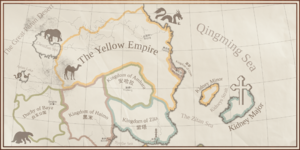Yellow Empire
Jump to navigation
Jump to search
Yellow Empire | |
|---|---|
| from $year – to 1500s | |
Coat of arms
| |
| The Yellow Empire at its greatest extent The Yellow Empire at its greatest extent | |
| Capital | $Place |
| Common languages | $language(s) |
| Religion | $religion(s) |
| Government | Absolute monarchy |
| Legislature | $legislature |
| Currency | $currency |
| Today part of | |
This article or section is in the process of an expansion or major restructuring. You are welcome to assist in its construction by editing it as well. If this article or section has not been edited in several days, please remove this template. If you are the editor who added this template and you are actively editing, please be sure to replace this template with {{in use}} during the active editing session. Click on the link for template parameters to use.
This article was last edited by Orioni (talk | contribs) 16 months ago. (Update timer) |
History
What we know so far about the Yellow Empire comes from a collection of various sources.
From Fulgistan
- Fulgistan was a key province of the Yellow Empire until its fall in the 1500s. The first state dominated by the Fulgistani people after the dissolution of the Yellow Empire emerged in 1655 with the formation of the Sultanate of Fulgistan.
- The area now known as Greater Fulgistan (including the disputed Takhar and Kunduz Conflict Zone) was once part of the Yellow Empire, first conquered by the Toujian Emperor in the 2nd century BCE, Fulgistan would become one of the core provinces of the Yellow Empire, whose rulers drew from it fine horses, cattle, fruits, and fierce warriors. Fulgistan would produce several emperors during its time as an imperial province, including the famed Zhanfang Emperor, during whose rule the Limonaian traveller Marco Palo passed through the country on his journey to the south. During the 10th century CE, traders from Sa Hara began visiting Fulgistan, importing both art and architecture, as well as Salam. When the Yellow Empire suffered its collapse in 1545, Fulgistan generally remained under the sway of the Cao Dynasty during the Snake and Tiger Period from the collapse until the 17th century. In 1655, the Sultanate of Fulgistan was established, marking the first cohesive Fulgi-dominated state in the area. In addition, the Sultanate was the first nation in eastern Alharu to practice Salam as a state religion, in contrast to the folk religion and various regional faiths of the Yellow Empire. However, even after unification under the Sultanate, the population remained decentralized, with most continuing to lead a pastoral, nomadic life.
From Yeosan
- Due to its proximity to the Yellow Empire at its founding, it has had a great influx of Huang culture into its own, creating one of its defining features as aforementioned.
- The geographic location of the island near Alharu and the Yellow Empire caused much of the culture of the area to make its way into the culture of the settlers through both trade and communication with nearby civilisations, as well as interactions with the original inhabitants of the island, most of whom fled back to the Yellow Empire after the original settlers arrived.
- After an intense, long, voyage through the Adlantic Ocean, the settlers found they had landed upon a most beautiful island whose centre was a magnificent mountain (unknown to them at the time that the mountain was actually a volcano). So magnificent that they made it a sacred site in their religion. The settlers soon made contact with small settlements of people from the Yellow Empire who, due to sickness being unknowingly spread by the settlers, fled back to mainland Alharu and the Yellow Empire, although some who were not affected stayed behind and joined the settlers in establishing their new nation. With this, the settlers began repopulating the villages for their own and began to absorb the motifs, and other cultural aspects left behind in the villages, as they saw most aspects of their old culture as barbaric after their staunch persecution. During this time (1550s-1750s) the nation was incredibly open and saw a massive influx of Huang culture into their nation, creating a unique mesh of Europan and Huang cultures which Yeosan is known for today.
From Heiheguo
- The name "Heiheguo" is thought to originally have been an endonym given by the nations of the Yellow Empire. What the Heiheren originally called themselves is currently unknown.
From Rhava
- Most of early Rhavanese history talks about the many wars between the Rhavanese kingdoms and the Yellow Empire. It's said that one of the reasons the Yellow Empire was not able to take over the country fully was because they were not used to fighting in the thick jungles and mountains, and under the sweltering sun. They nicknamed the area 日国,the sun kingdom.
- The Yellow Empire influenced much of northern Rhava, providing a unique style of Architecture, and bringing to the Rhava the language of Huang, which through the ages became a Rhavanese dialect that is still used and taught in modern day.
- Even after the fall of the Yellow Empire, Rhava still has a similar rocky relationship with the successors of the empire, such as Fulgistan.

